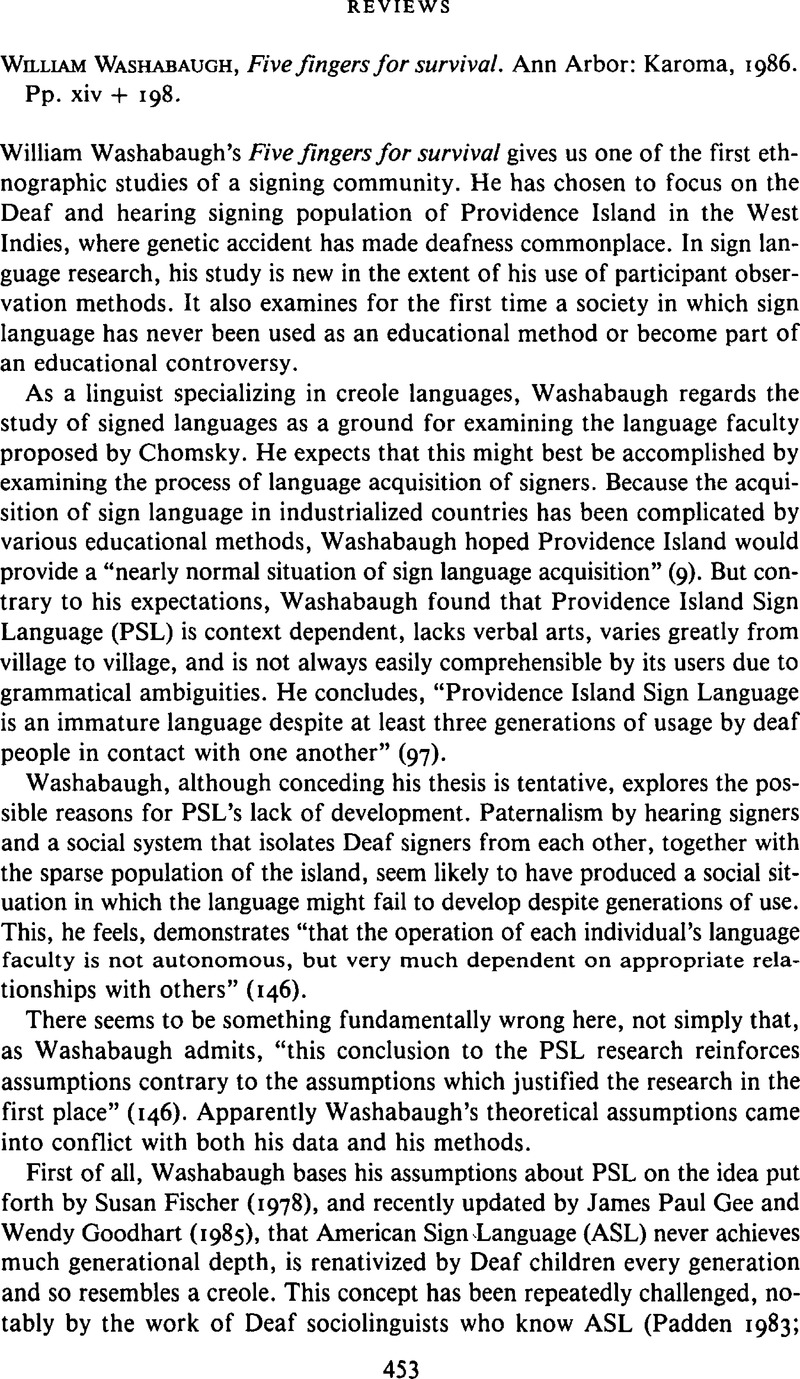No CrossRef data available.
Article contents
William Washabaugh, Five fingers for survival. Ann Arbor: Karoma, 1986. Pp. xiv + 198.
Published online by Cambridge University Press: 18 December 2008
Abstract
An abstract is not available for this content so a preview has been provided. Please use the Get access link above for information on how to access this content.

- Type
- Book Review
- Information
- Copyright
- Copyright © Cambridge University Press 1989
References
REFERENCES
Baker, C., & Padden, C. (1978). American Sign Language: A look at its history, structure, and community. Pamphlet, Silver Spring, MD: T. J. Publishers.Google Scholar
Carmel, S. (1980). Folklore genres of the American deaf community. Paper presented at the American Folklore Society Annual Meeting, Pittsburgh.Google Scholar
Carmel, S. (1981). American folklore in the deaf community. A videotape by Gallaudet College Television, Washington, DC, in cooperation with the Smithsonian Festival of American Folk-life. Produced and directed by S. J. Carmel. 56 min., color, sound, sign, and voice.Google Scholar
Cokely, D. R., & Baker, C. (1981). American Sign Language. 5 vols. Silver Spring, MD: T. J. Publishers.Google Scholar
Fischer, S. (1978). Sign language and Creoles. In Siple, P. (ed.), Understanding language through sign language research. New York: Academic. 309–31.Google Scholar
Gee, J. P., & Goodhart, W. (1985). Nativization, linguistic theory, and deaf language acquisition. Sign Language Studies 49: 291–342.Google Scholar
Groce, N. (1985). Everyone here spoke sign language: Hereditary deafness on Martha's Vineyard. Cambridge, Mass.: Harvard University Press.Google Scholar
Hall, S. (1986). “Here we sign”: Functions of folklore in the socialization of Deaf youths. In Christiansen, J. B. & Meisegeier, R. W. (eds.), Papers for the Second Research Conference on the Social Aspects of Deafness. Washington, DC: Gallaudet College, Department of Sociology and Social Work.Google Scholar
Hymes, D. (1971). Sociolinguistics and the ethnography of speaking. In Ardener, E. (ed.), Social anthropology and language (ASA Monographs, 10.) London: Tavistock. 47–93.Google Scholar
Hymes, D. (1974). Foundations in Sociolinguistics: An ethnographic approach. Philadelphia: University of Pennsylvania Press.Google Scholar
Padden, C. (1983). Unpublished Ph. D. dissertation, University of California at San Diego.Google Scholar
Radner, J. (1980). Signlore: The poetic sleight-of-hand of the deaf. Paper presented at the American Folklore Society Annual Meeting, Pittsburgh.Google Scholar
Stokoe, W. (1965). A dictionary of American Sign Language on linguistic principles. Silver Spring, MD: Linstock.Google Scholar
Supalla, T. (1982). Acquisition of morphology ofASL verbs of motion and location. Unpublished Ph. D. dissertation, University of California at San Diego.Google Scholar
Supalla, T., & Newport, E. (1978). How many seats in a chair? The derivation of nouns and verbs in American Sign Language. In Siple, P. (ed.), Understanding language through sign language research. New York: Academic. 91–131.Google Scholar
Washabaugh, W. (1981). Sign language in its social context. Annual Review of Anthropology 10: 237–52.Google Scholar


